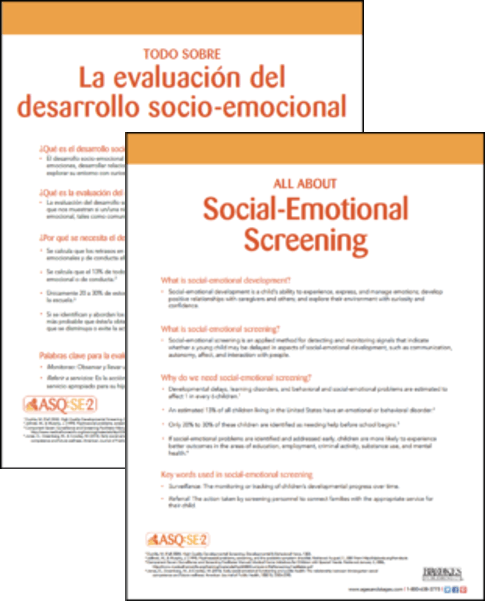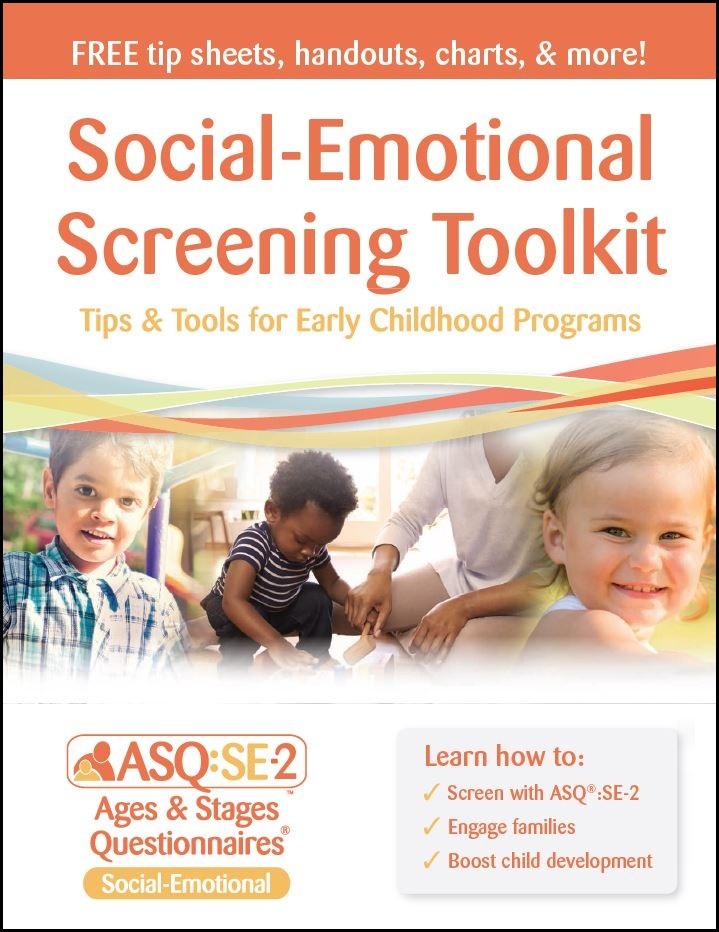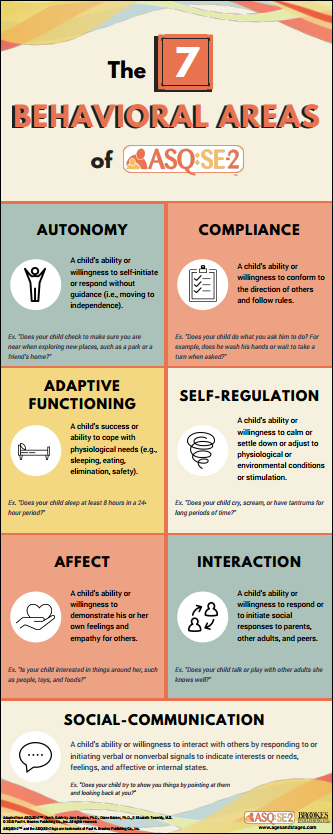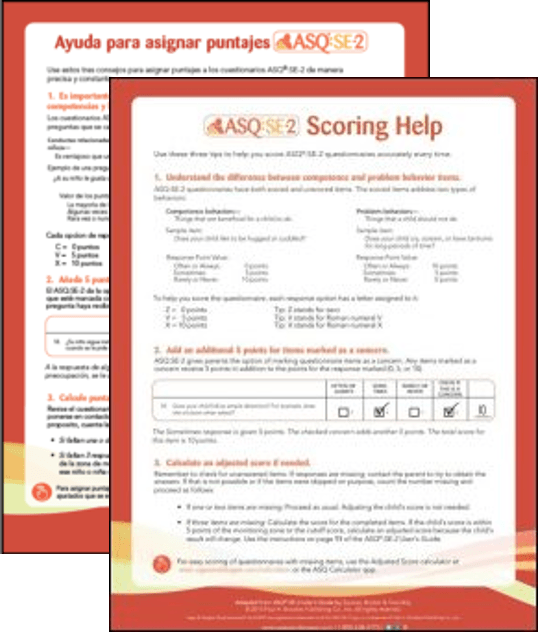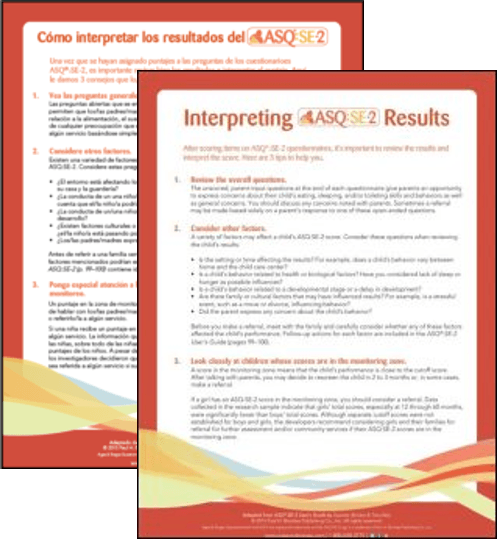Your Top ASQ:SE-2 Questions Answered

Since the release of the second edition of Ages & Stages Questionnaires®: Social-Emotional, we’ve received a lot of questions on a range of topics. Read below as we answer the most popular questions.
Why is social-emotional development important?
Children’s ability to regulate their emotions and skillfully manage social interactions is critical to their healthy development and future success. Beginning at birth, babies use vocalizations and body movements to begin building relationships. These relationships help young children feel a sense of comfort, safety and confidence—all necessary for forming friendships, communicating emotions and dealing with challenges.
Ensuring that every child has strong social-emotional skills through screening, early identification, and competence-building exercises helps prepare them for school, stop the bullying epidemic, and improve their well-being. And all of this helps set children up for future success! A recent study, also found significant associations between stronger social-emotional skills in kindergarten and better life outcomes in the areas of education, employment, criminal activity, substance use, and mental health.
To learn more about the importance of social-emotional development and how you can promote it in your program, read this article.
Should ASQ:SE-2 be used with every child?
|
Tips and tools for early childhood programs |
Yes, the ASQ® developers recommend every child be screened with ASQ®:SE-2 as a measure of behavior and social-emotional skills. Social-emotional skills are an important part of development; these skills are critical for school readiness, and identifying any delays early can reduce the likelihood of later serious behavior or mental health problems. Using ASQ:SE-2 alongside ASQ®-3 helps to provide a comprehensive look at a child’s development.
Some programs may experience budgetary constraints that prevent them from screening all children with ASQ:SE-2. These programs may choose to screen only children that score below the cutoff on the Personal-Social and/or Communication domains of ASQ-3. In this scenario, the developers also recommend administering ASQ:SE-2 if a parent expresses concerns related to his or her child’s social-emotional development or behavior.
If a child has a diagnosed cognitive or physical disability, the developers recommend using ASQ:SE-2 in a slightly different manner. ASQ:SE-2 can be used to provide a profile of the child’s strengths and problem behaviors for parents and caregivers, but because children with disabilities often score above the cutoff, the score should not be compared to normative cutoff scores.
My program has been using ASQ:SE for several years. Do I need training to use the second edition?
No, users of the first edition do not need additional training to use ASQ:SE-2. However, please note that it is critical that program staff understand the implementation changes for ASQ:SE-2, especially those related to prematurity, missing items, and using the monitoring zone. The changes are explained in the ASQ®:SE-2 User’s Guide. Programs will also find the ASQ®:SE-2 Quick Start Guide and ASQ®:SE-2 in Practice DVD to be helpful resources.
ASQ:SE-2 also includes several new features, including the “What Is ASQ:SE-2?” parent handout, information sheet for pediatricians, and optional item response sheets. These new features are described in the User’s Guide.
Why are there not separate scores for each of the areas covered by ASQ:SE-2?
ASQ:SE-2 screens children in seven areas of social-emotional development—self-regulation, compliance, social-communication, adaptive functioning, autonomy, affect, and interaction with people. However, only one total score is provided, as opposed to scores for each of the seven areas. The ASQ developers examined the possibility of providing subscale-scores, but found that data for the individual areas was not discrete enough to support subscale scoring. That is, there is significant overlap in many of the areas, and items target multiple areas or skills. The seven behavioral constructs can help users understand the organization of ASQ:SE-2 and the intent of individual questions, but the areas cannot be “teased apart.”
There is a chart on pages 33–35 of the ASQ:SE-2 User’s Guide that shows the area (e.g., self-regulation, compliance) where each individual questionnaire item falls. This chart is useful to see if a child is having trouble in one particular area.
Do I need to adjust a child’s age for prematurity?
Yes, ASQ:SE-2 requires you to adjustment for prematurity. A child’s age is adjusted if he or she is 3 or more weeks premature and is under 2 years of chronological age. Using the adjusted age is important because the cutoff scores were established using children whose ages were adjusted. And, not adjusting for prematurity may over-refer children for regulatory concerns that are a result of prematurity.
Use our free online age calculator to help select the correct questionnaire. The ASQ age calculator is also available as an app for iOS and Android devices.
Is ASQ:SE-2 an autism screener?
While ASQ:SE-2 is not an autism screener, the questionnaires contain items designed to detect behavioral and communication concerns that may point to autism. Results from ASQ:SE-2 may assist programs in making decisions about referrals for autism spectrum disorder (ASD) testing.
Ongoing research is being conducted, but preliminary analyses suggest that ASQ:SE-2 should identify the majority of children with ASD. The classification of children on ASQ:SE-2 was compared for 133 children between 18 and 60 months of age with a diagnosis of ASD. The overall agreement between a child’s ASQ:SE-2 classification and ASD classification was 83.5%.
For a summary of ASQ:SE-2 and ASQ-3 items related to behaviors associated with ASD, see Table C.12 in the ASQ:SE-2 User’s Guide.
Why is the scoring different (and harder) for ASQ:SE-2?
|
Need help scoring ASQ:SE-2? |
Unlike ASQ-3, which only addresses competence behaviors (e.g., does your child catch a large ball with both hands?), ASQ:SE-2 addresses both competence and problem behaviors. As a result, there is not a set number of points for a given response, and scores above the cutoff indicate a concern.
For problem behavior questions, like “Does your child cry, scream, or have tantrums for long period of time?” the Most of the Time choice has a X next to it, which indicates that there are 10 points associated with that response, while the Rarely or Never choice has a Z for 0 points. This behavior is a concern so there are higher points associated with it.
For competence (positive) behavior questions, such as “When upset, can your child calm down within 15 minutes?” the Most of the Time choice has a Z next to it, which indicates that there are 0 points associated with that response. The Rarely or Never choice has a X next to it for 10 points. This behavior is not a concern so there are zero points associated with it.
Professionals scoring ASQ:SE-2 questionnaires by hand can use a simple formula to convert parents’ responses to points:
- Each Z response is assigned 0 points
- Each V response is assigned 5 points
- Each X response is assigned 10 points
- Each checked concern is assigned 5 additional points
Automated scoring is also available through ASQ® Pro or ASQ® Enterprise, which helps ensure accuracy and saves time.
Can child care providers or teachers complete ASQ:SE-2 questionnaires for children?
The authors recommend that practitioners enlist parents to complete the questionnaires whenever possible. ASQ was developed and validated as a parent-completed tool, and many studies have found parents to be reliable evaluators of children’s behavior. Read more here.
If a program chooses to have teachers complete the questionnaires, guidelines require that they have at least 15 to 20 hours of contact with the child each week, for at least a month. This ensures that the person completing the questionnaire is familiar with the child’s skills. The ASQ developers also recommend collaborating with parents, especially when the professional is unsure about a particular item. Read this article to learn more about how teachers and parents can collaborate when completing ASQ questionnaires.
What should I consider as I interpret ASQ:SE-2 results?
|
Helpful tips for interpreting results |
If a child scores in the monitoring zone or above the cutoff, work with the family to consider the factors that may be impacting the child’s behavior before you begin the follow-up process. Rather than a referral, it may be more appropriate to opt for close monitoring and preventive measures as a first step.
One example is a child who hits others. If that child has a speech delay, her negative behavior may be because she’s frustrated that she can’t easily verbally communicate her needs. A speech-language pathologist may be a more appropriate first-step referral than a mental health professional.
Factors to keep in mind include setting and time, developmental issues, health and medical issues, family/cultural issues, and parent concerns. These factors are included on a helpful checklist on the ASQ:SE-2 information summary sheet. To learn more about factors to consider when interpreting ASQ results, read this article.
What should we do if a child scores in the monitoring zone?
An ASQ:SE-2 score in the monitoring zone represents a score close to the cutoff and indicates the need for monitoring. The developers recommend rescreening the child in 2–4 months and sharing the social-emotional parent–child activity sheets found in the back of the ASQ:SE-2 User’s Guide. Professionals may also want to share the social-emotional development guides from the User’s Guide with parents.
If the child is a girl, the developers recommend considering a referral for further evaluation. Data collected in the renorming of ASQ:SE-2 indicated that girls’ total scores were significantly lower than boys’ scores. For more information about the difference in boys’ and girls’ performance on ASQ:SE-2, see the technical report in the ASQ:SE-2 User’s Guide.
***
Do you have an ASQ:SE-2 question that we didn’t cover? Submit it to the FAQ Knowledge Base.
Originally published: January 2017
Updated: October 2019


